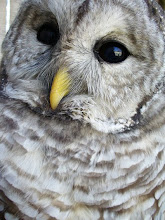 The American Kestrel (Falco sparvericus) is North American's smallest falcon. As in most other species of raptors, the female kestrel is larger than the male-- but unlike most other raptor species, American Kestrels are sexually dimorphic in colour, which means that the males and the females have very different markings. These quick little birds were once known colloquially as 'sparrow-hawks', and although they are not a hawk, they do prey on birds such as sparrows, finches, warblers, and even doves! They also hunt large insects and small rodents. They are the only North American falcon that often 'hovers' in the air while hunting.
The American Kestrel (Falco sparvericus) is North American's smallest falcon. As in most other species of raptors, the female kestrel is larger than the male-- but unlike most other raptor species, American Kestrels are sexually dimorphic in colour, which means that the males and the females have very different markings. These quick little birds were once known colloquially as 'sparrow-hawks', and although they are not a hawk, they do prey on birds such as sparrows, finches, warblers, and even doves! They also hunt large insects and small rodents. They are the only North American falcon that often 'hovers' in the air while hunting. The Mountsberg Raptor Centre is proud to announce a new resident American Kestrel-- a young male. Male kestrels make up for their small stature with their excellent maneuverability and brightly coloured plumage. With a blue cap and wings, this as-of-yet-nameless male cuts a dashing figure at only nine months of age. In captivity, kestrels can live as long as 15 years. The new male (picture at left) joins current Mountsberg resident kestrels Conan, Lizzie (pictured below), and Katy. Keep an eye on our Facebook Page to receive future updates on this little boy and all the other Raptor Centre residents!
The Mountsberg Raptor Centre is proud to announce a new resident American Kestrel-- a young male. Male kestrels make up for their small stature with their excellent maneuverability and brightly coloured plumage. With a blue cap and wings, this as-of-yet-nameless male cuts a dashing figure at only nine months of age. In captivity, kestrels can live as long as 15 years. The new male (picture at left) joins current Mountsberg resident kestrels Conan, Lizzie (pictured below), and Katy. Keep an eye on our Facebook Page to receive future updates on this little boy and all the other Raptor Centre residents! Ontario has four native species of falcons. In order of increasing size, these species are the American Kestrel, the Merlin (Falco columbarius), the Peregrine Falcon (Falco peregrinus), and the Gyrfalcon (Falco rusticolus). Of the four, the American Kestrel is the most common species, and is relatively easy to spot in Southern Ontario. American Kestrels often perch on power-lines, telephone wires, and roadway signage. To see one, keep your eyes open for a robin-sized bird that repeatedly bobs its head and flicks its tail while perched-- chances are, it's a kestrel.
Ontario has four native species of falcons. In order of increasing size, these species are the American Kestrel, the Merlin (Falco columbarius), the Peregrine Falcon (Falco peregrinus), and the Gyrfalcon (Falco rusticolus). Of the four, the American Kestrel is the most common species, and is relatively easy to spot in Southern Ontario. American Kestrels often perch on power-lines, telephone wires, and roadway signage. To see one, keep your eyes open for a robin-sized bird that repeatedly bobs its head and flicks its tail while perched-- chances are, it's a kestrel.The next time you visit the Raptor Centre, be sure not to miss this diminutive but unique bird of prey. See you on the trails!
